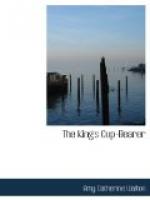It was the very king who had put one of his subjects to this death of awful torment before whom Nehemiah had to appear, and of whom he had to make a request. No wonder, then, that he dreaded the interview, and that he felt that he needed many months of prayer to make him ready for it. It was in the month Chisleu (December) that Hanani had arrived, it was not until Nisan (April) that he made up his mind to speak to the king.
Before leaving his room that morning, he knelt down, and put himself and his cause in the Lord’s hands, Neh. i. 11.
Then, attired in his official dress, the Rab-shakeh sets forth for the state apartments of the palace. The central building of that magnificent pile in which the king held court was very fine and imposing, as may be seen to-day from the extensive ruins of Shushan. In the centre of it was the Great Hall of Pillars, 200 feet square. In this hall were no less than thirty-six pillars, arranged in six rows, and all sixty feet high. Round this grand hall were the beautiful reception rooms of the king, and these were carefully arranged, in order to ensure perpetual coolness even in the hottest weather. There was no room on the hot south side of the palace, but on the west was the morning room, in which all the morning entertainments were held, whilst the evening banqueting hall was on the eastern side. By this arrangement the direct rays of the sun were never felt by those within the palace. Then, on the cool northern side was the grand throne room, in which the king sat in state, and through which a whole army of soldiers, or an immense body of courtiers, could file without the slightest confusion, entering and leaving the room by stone staircases placed opposite each other. The steps were only four inches in depth and sixteen feet wide, and were so built that horsemen could easily mount or descend them.
Into one of the grand halls of the palace Nehemiah the cup-bearer enters. The pavement is of coloured marble, red, white, and blue; curtains of blue and white, the Persian royal colours, drape the windows and are hanging in graceful festoons from the pillars; the fresh morning breeze is blowing from the snow-clad mountains, and is laden with the scent of lemons and oranges, and of the Shushan lilies and Persian roses in the palace gardens.
There is the royal table, covered with golden dishes and cups, and spread with every dainty that the world could produce.
There is the king, a tall, graceful man, but with one strange deformity—with hands so long that when he stood upright they touched his knees, from which he had received the nickname of Longimanus, the long-handed.
He is dressed in a long loose robe of purple silk, with wide sleeves, and round his waist is a broad golden girdle. His tunic or under-garment is purple and white, his trousers are bright crimson, his shoes are yellow, and have long pointed toes. On his head is a curious high cap with a band of blue spotted with white. He is moreover covered with ornaments: he has gold earrings, a gold chain, gold bracelets, and a long golden sceptre with a golden ball as its crown.




